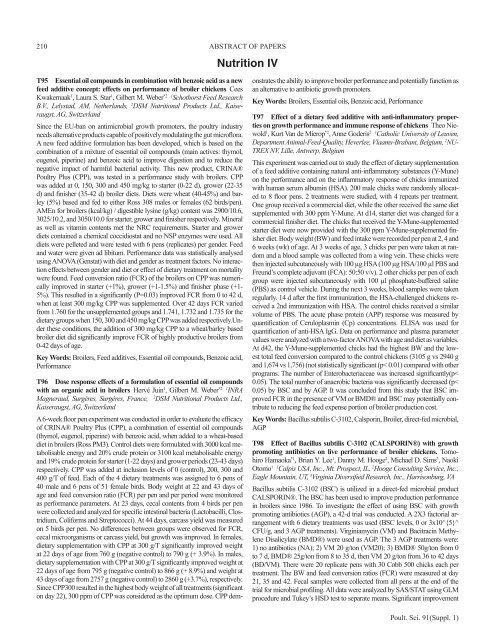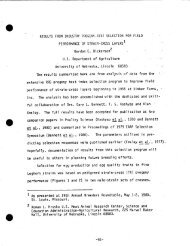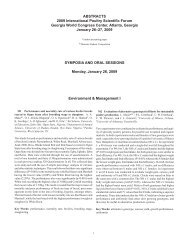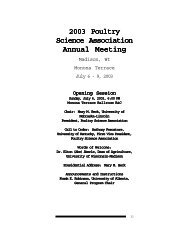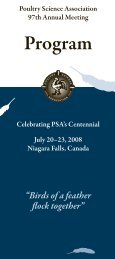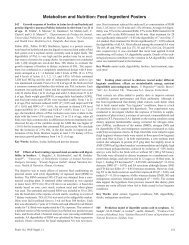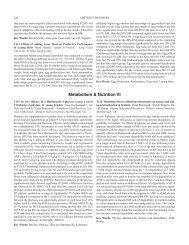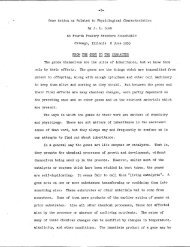IPSF Orals - Nutrition IV - Poultry Science Association
IPSF Orals - Nutrition IV - Poultry Science Association
IPSF Orals - Nutrition IV - Poultry Science Association
Create successful ePaper yourself
Turn your PDF publications into a flip-book with our unique Google optimized e-Paper software.
210 ABSTRACT OF PAPERS<br />
<strong>Nutrition</strong> <strong>IV</strong><br />
T95 Essential oil compounds in combination with benzoic acid as a new<br />
feed additive concept: effects on performance of broiler chickens Cees<br />
Kwakernaak 1 , Laura S. Star 1 , Gilbert M. Weber *2 1 Schothorst Feed Research<br />
B.V., Lelystad, AM, Netherlands, 2 DSM <strong>Nutrition</strong>al Products Ltd., Kaiseraugst,<br />
AG, Switzerland<br />
Since the EU-ban on antimicrobial growth promoters, the poultry industry<br />
needs alternative products capable of positively modulating the gut microflora.<br />
A new feed additive formulation has been developed, which is based on the<br />
combination of a mixture of essential oil compounds (main actives: thymol,<br />
eugenol, piperine) and benzoic acid to improve digestion and to reduce the<br />
negative impact of harmful bacterial activity. This new product, CRINA®<br />
<strong>Poultry</strong> Plus (CPP), was tested in a performance study with broilers. CPP<br />
was added at 0, 150, 300 and 450 mg/kg to starter (0-22 d), grower (22-35<br />
d) and finisher (35-42 d) broiler diets. Diets were wheat (40-45%) and barley<br />
(5%) based and fed to either Ross 308 males or females (62 birds/pen).<br />
AMEn for broilers (kcal/kg) / digestible lysine (g/kg) content was 2900/10.6,<br />
3025/10.2, and 3050/10.0 for starter, grower and finisher respectively. Mineral<br />
as well as vitamin contents met the NRC requirements. Starter and grower<br />
diets contained a chemical coccidiostat and no NSP enzymes were used. All<br />
diets were pelleted and were tested with 6 pens (replicates) per gender. Feed<br />
and water were given ad libitum. Performance data was statistically analysed<br />
using ANOVA (Genstat) with diet and gender as treatment factors. No interaction<br />
effects between gender and diet or effect of dietary treatment on mortality<br />
were found. Feed conversion ratio (FCR) of the broilers on CPP was numerically<br />
improved in starter (+1%), grower (+1-1.5%) and finisher phase (+1-<br />
5%). This resulted in a significantly (P=0.03) improved FCR from 0 to 42 d,<br />
when at least 300 mg/kg CPP was supplemented. Over 42 days FCR varied<br />
from 1.760 for the unsupplemented groups and 1.741, 1.732 and 1.735 for the<br />
dietary groups when 150, 300 and 450 mg/kg CPP was added respectively.Under<br />
these conditions, the addition of 300 mg/kg CPP to a wheat/barley based<br />
broiler diet did significantly improve FCR of highly productive broilers from<br />
0-42 days of age.<br />
Key Words: Broilers, Feed additives, Essential oil compounds, Benzoic acid,<br />
Performance<br />
T96 Dose response effects of a formulation of essential oil compounds<br />
with an organic acid in broilers Hervé Juin 1 , Gilbert M. Weber *2 1 INRA<br />
Magneraud, Surgéres, Surgéres, France, 2 DSM <strong>Nutrition</strong>al Products Ltd.,<br />
Kaiseraugst, AG, Switzerland<br />
A 6-week floor pen experiment was conducted in order to evaluate the efficacy<br />
of CRINA® <strong>Poultry</strong> Plus (CPP), a combination of essential oil compounds<br />
(thymol, eugenol, piperine) with benzoic acid, when added to a wheat-based<br />
diet in broilers (Ross PM3). Control diets were formulated with 3000 kcal metabolisable<br />
energy and 20% crude protein or 3100 kcal metabolisable energy<br />
and 19% crude protein for starter (1-22 days) and grower periods (23-43 days)<br />
respectively. CPP was added at inclusion levels of 0 (control), 200, 300 and<br />
400 g/T of feed. Each of the 4 dietary treatments was assigned to 6 pens of<br />
40 male and 6 pens of 51 female birds. Body weight at 22 and 43 days of<br />
age and feed conversion ratio (FCR) per pen and per period were monitored<br />
as performance parameters. At 23 days, cecal contents from 4 birds per pen<br />
were collected and analyzed for specific intestinal bacteria (Lactobacilli, Clostridium,<br />
Coliforms and Streptococci). At 44 days, carcass yield was measured<br />
on 5 birds per pen. No differences between groups were observed for FCR,<br />
cecal microorganisms or carcass yield, but growth was improved. In females,<br />
dietary supplementation with CPP at 300 g/T significantly improved weight<br />
at 22 days of age from 760 g (negative control) to 790 g (+ 3.9%). In males,<br />
dietary supplementation with CPP at 300 g/T significantly improved weight at<br />
22 days of age from 795 g (negative control) to 866 g (+ 8.9%) and weight at<br />
43 days of age from 2757 g (negative control) to 2860 g (+3.7%), respectively.<br />
Since CPP300 resulted in the highest body weight of all treatments (significant<br />
on day 22), 300 ppm of CPP was considered as the optimum dose. CPP demonstrates<br />
the ability to improve broiler performance and potentially function as<br />
an alternative to antibiotic growth promoters.<br />
Key Words: Broilers, Essential oils, Benzoic acid, Performance<br />
T97 Effect of a dietary feed additive with anti-inflammatory properties<br />
on growth performance and immune response of chickens Theo Niewold<br />
1 , Kurt Van de Mierop *2 , Anne Goderis 2 1 Catholic University of Leuven,<br />
Department Animal-Feed-Quality, Heverlee, Vlaams-Brabant, Belgium, 2 NU-<br />
TREX NV, Lille, Antwerp, Belgium<br />
This experiment was carried out to study the effect of dietary supplementation<br />
of a feed additive containing natural anti-inflammatory substances (Y-Mune)<br />
on the performance and on the inflammatory response of chicks immunized<br />
with human serum albumin (HSA). 200 male chicks were randomly allocated<br />
to 8 floor pens. 2 treatments were studied, with 4 repeats per treatment.<br />
One group received a commercial diet, while the other received the same diet<br />
supplemented with 300 ppm Y-Mune. At d14, starter diet was changed for a<br />
commercial finisher diet. The chicks that received the Y-Mune-supplemented<br />
starter diet were now provided with the 300 ppm Y-Mune-supplemented finisher<br />
diet. Body weight (BW) and feed intake were recorded per pen at 2, 4 and<br />
6 weeks (wk) of age. At 3 weeks of age, 3 chicks per pen were taken at random<br />
and a blood sample was collected from a wing vein. These chicks were<br />
then injected subcutaneously with 100 µg HSA (100 µg HSA/100 µl PBS and<br />
Freund’s complete adjuvant (FCA): 50:50 v/v). 2 other chicks per pen of each<br />
group were injected subcutaneously with 100 µl phosphate-buffered saline<br />
(PBS) as control vehicle. During the next 3 weeks, blood samples were taken<br />
regularly. 14 d after the first immunization, the HSA-challenged chickens received<br />
a 2nd immunization with HSA. The control chicks received a similar<br />
volume of PBS. The acute phase protein (APP) response was measured by<br />
quantification of Ceruloplasmin (Cp) concentrations. ELISA was used for<br />
quantification of anti-HSA IgG. Data on performance and plasma parameter<br />
values were analyzed with a two-factor ANOVA with age and diet as variables.<br />
At d42, the Y-Mune-supplemented chicks had the highest BW and the lowest<br />
total feed conversion compared to the control chickens (3105 g vs 2940 g<br />
and 1,674 vs 1,756) (not statistically significant (p< 0.01) compared with other<br />
programs. The number of Enterobacteriaceae was increased significantly(p<<br />
0.05). The total number of anaerobic bacteria was significantly decreased (p<<br />
0.05) by BSC and by AGP. It was concluded from this study that BSC improved<br />
FCR in the presence of VM or BMD® and BSC may potentially contribute<br />
to reducing the feed expense portion of broiler production cost.<br />
Key Words: Bacillus subtilis C-3102, Calsporin, Broiler, direct-fed microbial,<br />
AGP<br />
T98 Effect of Bacillus subtilis C-3102 (CALSPORIN®) with growth<br />
promoting antibiotics on live performance of broiler chickens. Tomohiro<br />
Hamaoka *1 , Brian Y. Lee 1 , Danny M. Hooge 2 , Michael D. Sims 3 , Naoki<br />
Otomo 1 1 Calpis USA, Inc., Mt. Prospect, IL, 2 Hooge Consulting Service, Inc.,<br />
Eagle Mountain, UT, 3 Virginia Diversified Research, Inc., Harrisonburg, VA<br />
Bacillus subtilis C-3102 (BSC) is utilized in a direct-fed microbial product<br />
CALSPORIN®. The BSC has been used to improve production performance<br />
in broilers since 1986. To investigate the effect of using BSC with growth<br />
promoting antibiotics (AGP), a 42-d trial was conducted. A 2X3 factorial arrangement<br />
with 6 dietary treatments was used (BSC levels, 0 or 3x10^{5}^<br />
CFU/g, and 3 AGP treatments). Virginiamycin (VM) and Bacitracin Methylene<br />
Disalicylate (BMD®) were used as AGP. The 3 AGP treatments were:<br />
1) no antibiotics (NA); 2) VM 20 g/ton (VM20); 3) BMD® 50g/ton from 0<br />
to 7 d, BMD® 25g/ton from 8 to 35 d, then VM 20 g/ton from 36 to 42 days<br />
(BD/VM). There were 20 replicate pens with 30 Cobb 500 chicks each per<br />
treatment. The BW and feed conversion ratios (FCR) were measured at day<br />
21, 35 and 42. Fecal samples were collected from all pens at the end of the<br />
trial for microbial profiling. All data were analyzed by SAS/STAT using GLM<br />
procedure and Tukey’s HSD test to separate means. Significant improvement<br />
Poult. Sci. 91(Suppl. 1)
ABSTRACT OF PAPERS 211<br />
(p
212 ABSTRACT OF PAPERS<br />
T102 Functional Oils are an Alternative to Pharmaceutical Growth Promoters<br />
in Turkeys. Peter Ferket *1 , Ramon Malhieros 1 , Vera Moraes 2 , Ayuub<br />
Ayoola 1 , Ilana Barasch 1 , Joan Torrent 3 1 North Carolina State University, Raleigh,<br />
NC, 2 Sao Paulo State University, Sao Paulo, Brazil, 3 Oligo Basics USA,<br />
Excelsior, MN<br />
Essential ® (Oligo Basics USA, Wilmington, DE), a blend of functional oils<br />
from cashew and castor beans, was evaluated as an alternative to monensin<br />
and virginiamycin on the growth performance of turkey toms. One day-old<br />
poults were placed in floor pens with used litter to provide a natural microbial<br />
challenge. Feed and water were provided for ad libitum consumption. Birds<br />
were randomly assigned to 3 dietary treatments from 1-84d: non-medicated<br />
control (C), 0.15% Essential ® (E), and 66 ppm Monensin (M). Each one of<br />
the 15 pens/treatment was then distributed among 3 other dietary treatments<br />
from 85-140d: C, E, and 20 ppm Virginiamycin (V), which resulted in 9 treatments<br />
(5 pen/treatment, ~13 toms/pen). Body weights (BW), feed intake (FI)<br />
and FCR (adjusted for mortality) were determined at 28d intervals. None of the<br />
treatments affected the mortality rate during experiment. At 84d, toms fed M<br />
and E were 10.5% and 4.5% heavier (P


